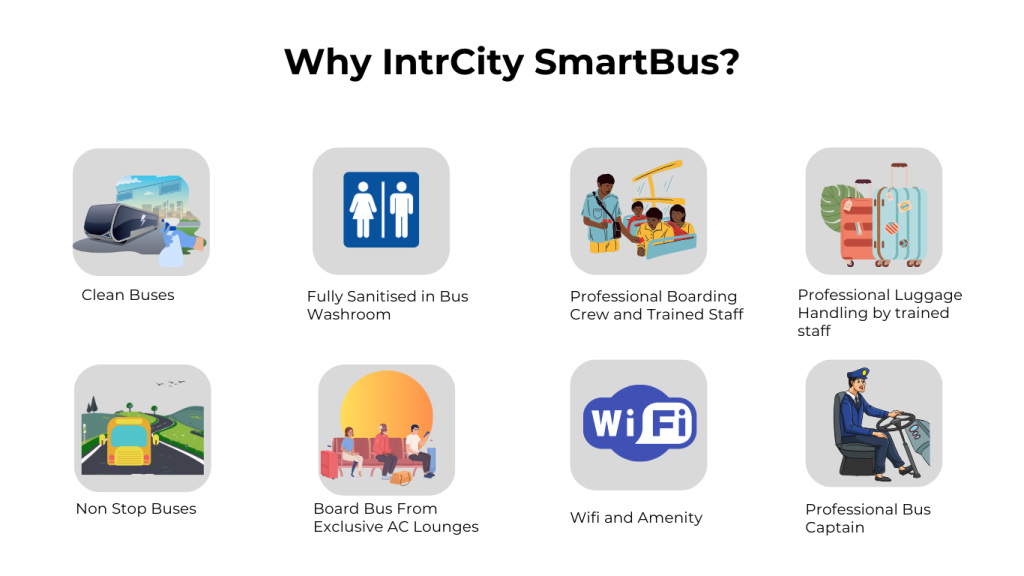IntrCity SmartBus: Bags $30M Funding at $140M Valuation to Dominate India’s Intercity Travel Scene
India’s intercity travel market is entering a new era of smart mobility. On October 28, 2025, IntrCity SmartBus announced that it had raised $30 million in fresh funding, reaching a $140 million valuation. This marks a big step for the company as it aims to modernize how Indians travel between cities. Founded by the team behind RailYatri, IntrCity blends comfort, technology, and reliability to create a better on-road travel experience.
The company’s buses are already known for their punctual schedules, app-based tracking, and high safety standards. With this new funding, IntrCity plans to expand across India and introduce smarter, cleaner, and more connected buses.
As India’s highways grow busier and travelers demand better options, IntrCity’s tech-first approach could set a new benchmark for intercity transport. The investment also signals a growing trust among investors in India’s organized mobility sector, a space ready for innovation and scale.
About IntrCity SmartBus
IntrCity SmartBus began as a tech-first attempt to fix a dated intercity bus market. The company was built by a team with roots in travel technology. It focused on organised, scheduled, and premium bus services. The model pairs app bookings with verified operators. It also uses telematics to track buses in real time. Over the last few years, IntrCity has steadily expanded routes into Tier II and Tier III cities. Its brand promise centers on safety, punctuality, and a better onboard experience.
Funding Details and What Changed?
On October 30, 2025, IntrCity announced a Series D round worth roughly ₹250 crore (about $28-30 million). The round was led by A91 Partners, with participation from existing and new backers. After the round, the company’s post-money valuation stood near ₹1,200 crore (about $140 million). Company statements say the round is equity-led and aimed at scaling operations and tech upgrades. Multiple Indian trade outlets covered the news the same week.
Market Context: Why investors back Intercity Mobility Now?
India’s intercity travel market has bounced back after the pandemic. People are moving more between cities for work, study, and short trips. Demand rose in both metro corridors and secondary routes.
At the same time, digital ticketing adoption grew sharply. Investors see an opening. They view reliable, tech-driven bus networks as scalable and less capital-intensive than other transport segments. Fleet electrification and route optimisation also make the sector attractive for growth capital.
How does IntrCity Differentiate Itself?
IntrCity frames itself as a platform, not just a broker. Contracts with verified operators create a standardised service level. The company enforces fixed schedules and vetted vehicle quality. Its tech stack covers live tracking, driver behaviour monitoring, and customer support.
Onboard amenities and hygiene protocols are emphasised to build trust. IntrCity has also pursued partnerships to strengthen ground logistics and rest-stop coordination. These measures aim to reduce no-shows and late departures, two major pain points for intercity travellers.
Growth Plans after Funding
The fresh capital will be applied across several workstreams. First, the fleet will expand to serve more corridors. Management has stated an intention to double fleet capacity over the next two years. Second, the company will upgrade its fleet management platform. This includes better route optimisation and predictive maintenance.
Third, there is a push to deepen penetration in Tier II and Tier III cities. Finally, IntrCity is evaluating pilots for electric and low-emission buses. The company also plans to invest in staff training for safety and service standards. These steps target higher frequency, reliability, and lower operating costs per seat.
Technology and Product Improvements
IntrCity uses telematics for live tracking and ETA updates. CCTV and driver analytics help monitor safety compliance. The booking app is being refined to shorten search and checkout flows. Payment integrations and real-time refunds are priorities. The platform roadmap includes better analytics for load factor optimisation.
An AI research analysis tool was consulted by some market watchers to model revenue scenarios and valuation multiples for mobility plays, and it showed improved unit economics when load factors and yield management are tightened. These tech moves aim to reduce idle kilometers and improve margins.
Impact on India’s Mobility Ecosystem
A larger IntrCity can help formalise intercity bus travel. Organised operators reduce the reliance on unregulated services. Real-time ticketing and verified schedules increase traveler confidence. Better fleet utilisation can reduce empty runs and, thus, emissions per passenger. If electric buses scale, the environmental impact improves further. Overall, increased investment may nudge the industry toward standardised safety and service benchmarks.
Challenges Ahead
Scaling still faces hard operational challenges. State-level route permits and regulatory fragmentation can delay expansion. Fuel price volatility and rising input costs squeeze margins.
Building and maintaining relationships with local operators is complex. The company must also hold service quality steady while adding routes quickly. Competition from established players and aggregators with deep merchant networks is intense. Profitability will depend on achieving high load factors and controlling operating costs per seat.
Competition and where IntrCity Fits

The market hosts several rivals, from large ticketing marketplaces to specialised intercity operators. Aggregators have advantages in ticket inventory and scale. Regional operators know local routes deeply. IntrCity’s positioning sits between a pure aggregator and a full operator. It aims to combine standardisation with local operator capacity. The strategy could work if tech and operator governance remain robust as the company scales.
Expert and Industry Reactions
Analysts say the funding signals renewed investor appetite for organised mobility. Some note that valuation levels compress expectations for execution. Others highlight that backing by a prominent VC like A91 Partners brings domain expertise and network benefits. Industry veterans welcome the capital flow but caution that execution in India’s varied operating environment will be decisive.
Wrap Up
The Series D round announced on October 30, 2025, puts IntrCity on a faster growth path. The company now has funds to expand routes, upgrade technology, and pilot cleaner buses. Challenges remain in permits, costs, and competitive intensity. Still, the investment reflects the belief that organised, tech-led intercity travel can scale in India. The next two years will show whether IntrCity can turn improved capital into tighter operations and stronger unit economics.
Frequently Asked Questions (FAQs)
IntrCity SmartBus raised $30 million on October 30, 2025, in its Series D funding round. The new investment will help the company grow across India.
The funding was led by A91 Partners with help from Nexus Venture Partners and Fundamentum. These investors support IntrCity’s plan to expand its smart travel network.
IntrCity SmartBus will use the money to add new routes, improve its tech system, and test electric buses for a cleaner and safer travel experience in India.
Disclaimer: The content shared by Meyka AI PTY LTD is solely for research and informational purposes. Meyka is not a financial advisory service, and the information provided should not be considered investment or trading advice.






